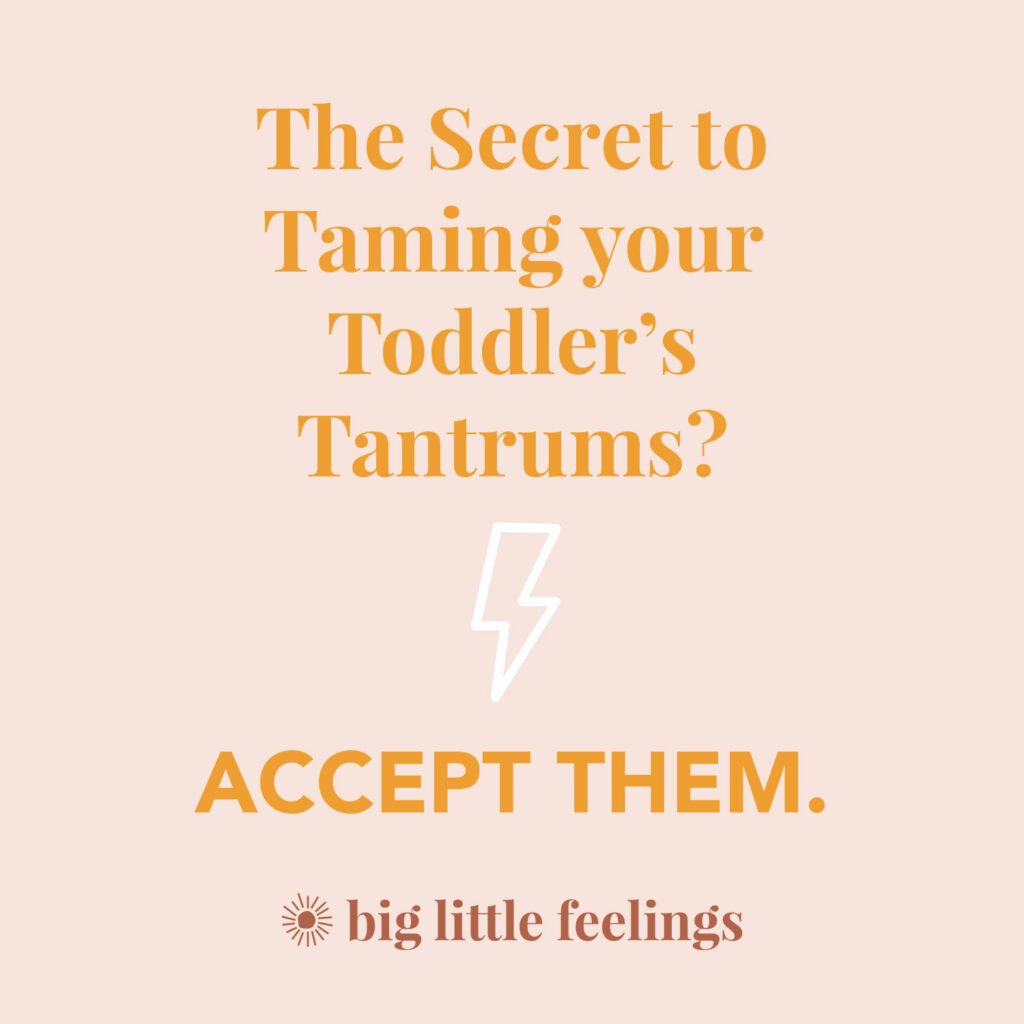
How to Manage a Tantrum Already in Progress
Go from Chaos to Calm in Three Simple Steps
You’ve no doubt noticed your toddler has a looooot of BIG feelings, many of which seem to make little sense (read: absolutely no freaking sense). And those feelings often result in some of the most epic meltdowns the world has ever seen.
- Like the time they full-on sobbed because you gave them the blueberries they ASKED for.
- Or the time they threw a fit because you gave them the wrong green cup. Even though you only own ONE green cup, and they pointed directly at it when they asked you for it.
- Or the time they flailed and wailed about wanting to go outside, when you were.already.outside.
Yeahhh. Sounds familiar. And the next thing you know, you’re looking around wondering if you’re on some hidden camera show, because how is this even real life right now? And also: What the F are you supposed to do about it?
Ooooh, we feel you. We’ve been there a time or two (or 22,000) ourselves. Here’s the good news: No matter how perplexing they seem, tantrums (and your feelings about them) are completely normal. In fact, they’re 100% biologically healthy—and mean your kiddo’s development is RIGHT ON TRACK. Their brains haven’t yet developed the networks that help them manage emotions and express themselves with language, which is exactly why you see them wailing and flailing when upset.
We get how “tantrums are normal” may not feel like good news. So peep this, instead: You don’t have to feel helpless in the face of a meltdown. While it may seem like your only options are to a) give in or b) grit your teeth and wait it out, there’s actually a third, and much more effective, way to deal.
You’re about to learn three simple steps to help dial down the intensity of your toddler’s tantrums and give you the confidence to handle whatever they throw at you… sometimes literally.
Tantrum-Taming Step #1: Allow the Feels
Here’s the scoop: Toddlers don’t know how to talk out their BIG feelings, so they tantrum them out instead. Our job as parents is to help them learn to express those feelings and cope with them in healthy ways.
So, don’t spend a single second trying to figure out WHY they’re melting down (the world may never know), and instead, allow the feelings fueling it.
Wait. Hold up. Did we just say you should allow the tantrum?
Nope, we didn’t. You’re going to allow the feelings, which is different than being cool with the behavior. We know it’s a bit of a paradigm shift, but we promise it’s backed by science and years of experience working with toddlers like yours.
Allowing or “okaying” the feelings has a calming effect on your child because it makes them feel seen and heard.
We can bet you’ve experienced this yourself. Think back to the last time you were BEYOND fired up about something… maybe you had a horrible day at work or you were home with the kiddos by yourself all dang day and you are BEYOND DONE. And your partner or boss or bestie showed up, asked you what’s wrong, and after you word-vomited all over them, they looked you in the eye and said, “I don’t know why you’re so upset. It’s not a big deal. You should just get over it.”
OOOOOOF!!! That didn’t help the situation at ALL, did it? In fact, you likely felt MORE keyed up and MORE upset and MORE, well, MELTDOWN-ISH, right?
But if they had looked at you and said, “Wow, I hear how frustrated you are. It’s totally okay to be upset”—well, your shoulders would’ve relaxed and your blood pressure would’ve dropped a tiny bit, right?
It works the exact same way with your kiddo. You’re going to use the magic phrases “I see” and “I hear” to help them handle their feelings.
It might sound like this:
- I hear you’re frustrated because you don’t want to take a nap. It’s so tough, because you want to keep playing.
- I can see you’re upset about the green bowl. You feel sad, and it’s OK to feel sad.
- It’s time to close the iPad now. I know you’re disappointed… it can be so hard turning it off. I hear you want to watch another show.
No matter the scenario, you’re going to calmly verbalize what’s happening, see them, and okay the feeling.
Now we know this seems a little (or a lot) touchy-feely—especially to those who weren’t raised in feelings-friendly homes (us included). We talk a lot about the research behind allowing the feels in our course Winning the Toddler Stage, but here’s the TL;DR:
Okaying the feelings will help your child become mentally healthy and resilient. It doesn’t make them overly sensitive or emotional; instead it teaches them the healthy coping skills they’ll use all the way to adulthood!

Tantrum-Taming Step #2: Tell Them Where the Boundaries Are
Once your toddler feels seen and heard, then it’s time to restate the boundaries.
You see, feelings are just half of the equation, so we can’t stop there. Boundaries provide the STRUCTURE, which helps reduce the frequency of tantrums. Because the last thing we want is to create a pattern resulting in MORE tantrums. Obvi.
Here’s the dealio: Your toddler has to learn healthy ways to handle disappointment, because disappointment is just a part of life. Consistently enforcing boundaries allows them opportunities to learn how to cope when they don’t get their way.
Is it fun to remind your child of the boundaries, especially while they’re screaming, “NOOOOOO NONONONONONONONO!” at you? Nope.
Is it easy to consistently put up those boundaries, especially when it’s bedtime, you’re exhausted, and you would give anything for just two seconds of peace and quiet? For sure, no.
But are you the cool, calm warrior parent committed to raising an emotionally healthy child?
Heck yeah, you are!
Tell your toddler what the boundaries are immediately after you okay the feelings:
- I hear you’re frustrated because you don’t want to take a nap. It’s so tough, because you want to keep playing. Right now it’s time for a nap.
- I can see you’re upset about the green bowl. You feel sad, and it’s OK to feel sad. We are not getting another bowl right now.
- It’s time to close the iPad now. I know you’re disappointed… it can be so hard turning it off. I hear you want to watch another show, and it’s time for dinner now.
Remember, you’re not explaining or negotiating the boundary. You’re simply re-stating it so they know where the limits are.
Tantrum-Taming Step #3: Shift to the Yes
You know what toddlers hear a lot of? The word “no.”
- No, you can’t eat the dog’s food.
- No, you can’t touch the fire in the fireplace.
- No, you can’t swing from the ceiling fan.
Hearing “no” all the time creates frustration for them, which is why highlighting a yes is such an important part of handling a meltdown. Don’t freak out: The yes isn’t some big, expensive offering. It’s simply something for your toddler to look forward to or have some say in.
Our favorite way to highlight the yes is to give a choice between two things. Toddlers want power and control (understatement of the year, right there), so highlighting a yes with a choice makes them feel large and in charge. And it also helps bring the tantrum closer to an end, which is what we want!
- I hear you’re frustrated because you don’t want to take a nap. It’s so tough, because you want to keep playing. Right now it’s time for a nap. Would you like to play on the swing or in the sandbox after your nap?
- I can see you’re upset about the green bowl. You feel sad, and it’s OK to feel sad. We are not getting another bowl right now. What toy are you going to play with after we eat?
- It’s time to close the iPad now. I know you’re disappointed… it can be so hard turning it off. I hear you want to watch another show, and it’s time for dinner now. Would you like your Daniel Tiger cup or your Elsa cup at dinner?
Ditch the Guilt and Insecurity
When you consistently practice these three steps, you’ll definitely see meltdowns lessen in duration and frequency. But something even better happens, too. Approaching a tantrum in this way allows you to stay strong and calm in the moment, instead of responding out of your own frustration, impatience, and stress. That means instead of feeling guilty for losing it on your toddler, you’ll feel proud, confident, and capable. High five!
Want to Go from Surviving to Thriving?
These three steps come from our guaranteed-to-squash-those-tantrums technique called BREATHE, which you’ll learn when you take our online course, Winning the Toddler Stage. Inside the course, you’ll find a variety of scripts for every possible meltdown your toddler might have, so you’ll know EXACTLY what to say and do. It’s the essential course you need to help your 1- to 6-year-old become an emotionally healthy, resilient, compassionate human.
Go from enduring the toddler stage to enjoying it. No, SERIOUSLY! Check out Winning the Toddler Stage.
